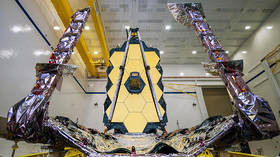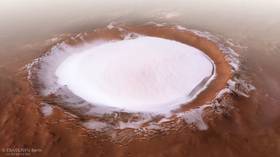Hubble’s high-tech successor: Huge new alien-hunting telescope unveiled by NASA (PHOTOS)

NASA has finally assembled its state-of-the-art James Webb Space Telescope, the successor to the mighty Hubble. The new craft is tasked with the lofty goal of searching for alien life and studying the origins of the universe.
The agency’s new big space observatory has been plagued with delays and cost overruns since it was announced in 2009, doubling its initial price tag to now reach some $9.7 billion (and counting) with an additional seven-year launch delay. The mission is expected to launch in March 2021.
The most powerful and complex space telescope ever created by humankind has achieved its final form as a fully assembled observatory. Reaching a major milestone, engineers have successfully connected the two halves of #NASAWebb More about this milestone: https://t.co/ZRwjFwMj6Ipic.twitter.com/RlWcKhERBp
— NASA Webb Telescope (@NASAWebb) August 28, 2019
Engineers gently lowered the telescope onto the craft’s body using a crane Wednesday. The entire object will eventually be surrounded by a complex foldable sun shield to protect the high-tech instruments onboard throughout its operational life.
The craft’s two halves were then attached manually but technicians have yet to hook up all of the electronics.
Once launched, the tennis court-sized Webb Telescope will view the universe in the infrared spectrum of light from the Sun-Earth Lagrange Point 2, a gravitationally stable point in the solar system roughly 930,000 miles (1.5 million kilometers) from Earth.
The #USOpen starts today! Can you imagine a spacecraft the size of a tennis court? To see infrared light from faraway objects, #NASAWebb needs to be very cold! Our sunshield (~21x14 m in size) will shade Webb and keep it < ~50 Kelvin (-370°F or -223°C). https://t.co/1dD7d3EF9vpic.twitter.com/BDd4vH9zhw
— NASA Webb Telescope (@NASAWebb) August 26, 2019
The advanced telescope will hunt for signs of life on nearby planets and study the formations of the first stars and galaxies some 13.5 billion years ago, using a “galactic-scale magnifying glass” phenomenon known as gravitational lensing. The project is being spearheaded by NASA, with support from the European Space Agency and the Canadian Space Agency.
Also on rt.com Hubble captures hypnotizing PHOTO of distant planetary nebulaThink your friends would be interested? Share this story!














